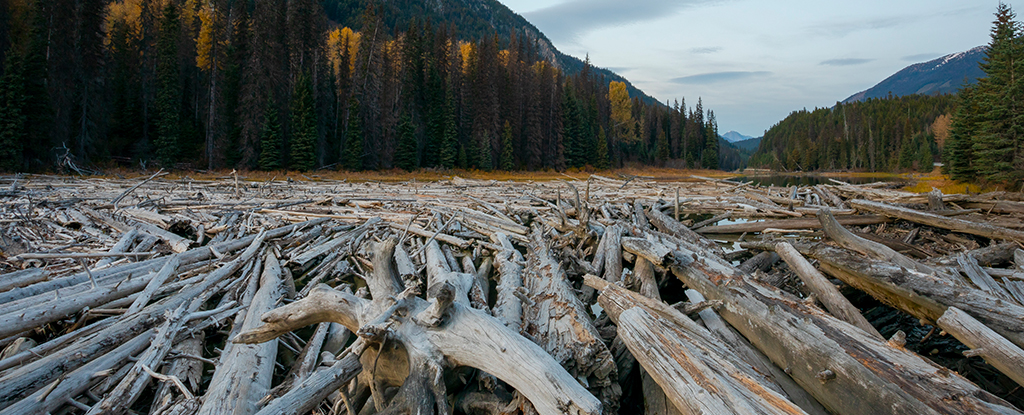Products You May Like
If you think your morning commute is a logjam, you should see the Mackenzie River Delta in Nunavut, Canada.
Unlike logjams of idling trucks, sedans, and SUVs, this literal logjam stores carbon.
Covering some 51 square kilometers (nearly 20 square miles) it’s the largest-known cumulative logjam on Earth, consisting of fallen trees that have floated downriver from surrounding forests and accumulated in the delta over the centuries.
According to a new study by researchers from the US and UK, those logs collectively hold about 3.4 million tons (3.1 million metric tons) of carbon, representing a significant but poorly understood carbon pool.
“To put that in perspective, that’s about two and a half million car emissions for a year,” says Alicia Sendrowski, a research engineer who led the study while at Colorado State University in the US. “That’s a sizable amount of carbon.”
Despite decades of data on how driftwood moves around the Arctic, we still don’t really know how much wood lurks in the region’s logjams – or how much carbon it holds.
“There’s been a lot of work on fluxes of carbon from water and sediment, but we simply didn’t pay attention to the wood until very recently,” says Virginia Ruiz-Villanueva, a fluvial geomorphologist at the University of Lausanne who wasn’t involved in the study.
“This is a very young field of research that is developing quite fast,” she adds. “And it’s important to study this wood not only for the carbon cycle, but in general for our understanding of how these natural fluvial systems work, how the rivers mobilize and distribute the wood.”
Logs last a long time in the Arctic, where low temperatures and low humidity can help preserve trees for centuries or even millennia after they fall.
The Mackenzie River abounds with logs of all ages, especially in its delta, the world’s third-largest by land area. For the new study, researchers studied about 13,000 square kilometers of the delta, the most ambitious such mapping effort ever made.
That included three weeks in the field, where the researchers measured driftwood, mapped logjams, and took samples to determine the age of individual logs with radiocarbon dating.
They also used satellite imagery to estimate the total surface area of the logjam, which is a conglomeration of about 400,000 smaller woody deposits. That helped them calculate the volume of wood within the logjam, thus work out the quantity of carbon it most likely stores.
The largest single deposit in the logjam spans the equivalent of about 20 American football fields, the researchers report, and it alone stores 7,385 tons (6,700 metric tons) of carbon.
While their research suggests the overall logjam stores 3.4 million tons of carbon, they point out that’s limited to logs they could observe from the surface. Legions of logs are also buried in the delta’s soil, hidden underwater, or obscured by plants, so the researchers acknowledge their estimate likely falls short. The full logjam might even hold twice that much carbon, they say.
That’s a lot, although it’s still dwarfed by the Mackenzie River Delta itself, whose carbon-rich soils already make it a hotspot for carbon storage. According to previous research, the delta may store close to 34 billion metric tons of carbon in total.
”But we think it’s still important because as changes in the basin occur, like logging or damming, and as climate change alters precipitation patterns and warming, wood preservation will decrease,” Sendrowski says.
“It’s a significant amount of carbon, so there’s a potentially significant loss of carbon storage,” she adds.
Under natural conditions, the Arctic can preserve logs – and hold their carbon – for quite a while. About 40 percent of logs sampled by the researchers began growing in 1955 or later, but many were older, some dating back to 690 CE.
And the Mackenzie River Delta isn’t alone. The Arctic has at least a dozen river deltas of more than 500 square kilometers, the researchers note, potentially forming a network of carbon-storing logjams we’d be wise to study and protect.
“The exciting aspect for me isn’t just the scale, but also the potential to apply this to other places where large wood hasn’t been focused on,” Sendrowski says.
The study was published in Geophysical Research Letters.
